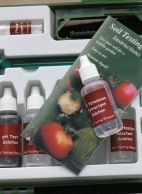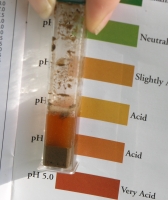Testing our soil and the results
We have now had the chance to take a good look at the soil we have in Brittany.
 Test kits designed for the amateur are readily available at a reasonable cost. The quantity of reagent is limited but still sufficient. The one we used tests for acidity Ph, Nitrogen N, Phosphorous P and Potassium K
Test kits designed for the amateur are readily available at a reasonable cost. The quantity of reagent is limited but still sufficient. The one we used tests for acidity Ph, Nitrogen N, Phosphorous P and Potassium K
As it is quite a large site we took samples from the top of the land,(where the soil is thinnest) the middle and the bottom, (where we have deeper top soil), then checked them individually.
 You can see from this photo of the soil horizon near the back of the house (roughly in the midle of the land), that the top soil is quite thin, very quickly turning to broken granite 100mm graticule .
You can see from this photo of the soil horizon near the back of the house (roughly in the midle of the land), that the top soil is quite thin, very quickly turning to broken granite 100mm graticule .
 To take the samples, we dug down about 150mm (6in), and collected a small amount of soil, taking care to avoid plant roots and organic matter. We placed the soil samples in labled open containers (in fact the bottoms of plastic milk bottles),removing stones and organic matter, and in one sample a few ants!
To take the samples, we dug down about 150mm (6in), and collected a small amount of soil, taking care to avoid plant roots and organic matter. We placed the soil samples in labled open containers (in fact the bottoms of plastic milk bottles),removing stones and organic matter, and in one sample a few ants!
We took the samples indoors to dry out and once dry we were able to carry out the testing.
As far as nutrient levels go, as expected they are very low, good for wild flowers but will definitely need beefing up for other things, (except where we want to keep the wild flowers of course).
 The acidity result was 5.5 so rhododendrons, camellias etc will love it, most perennials will be OK but the vegetables will need some lime. This reading too, seemed uniform across the land and bears out what we had thought from looking in other peoples gardens.
The acidity result was 5.5 so rhododendrons, camellias etc will love it, most perennials will be OK but the vegetables will need some lime. This reading too, seemed uniform across the land and bears out what we had thought from looking in other peoples gardens.
Looking at the soil structure
The crumb structure is good but easily damaged, we know because the soil surface where the ground is bare just outside the house, capped very easily after rain.
We left a soil sample to settle in a cylindrical container. It took a long time to clear as the fine particles are easily held in suspension but after a day or two nearly all the soil particles had settled out. There were very few obviously larger particles, some particles of mica were visible but the rest looked fine to very fine.